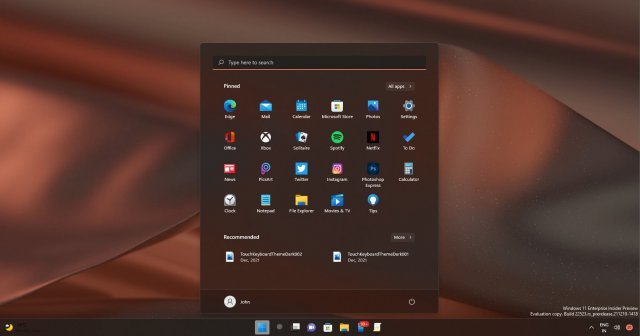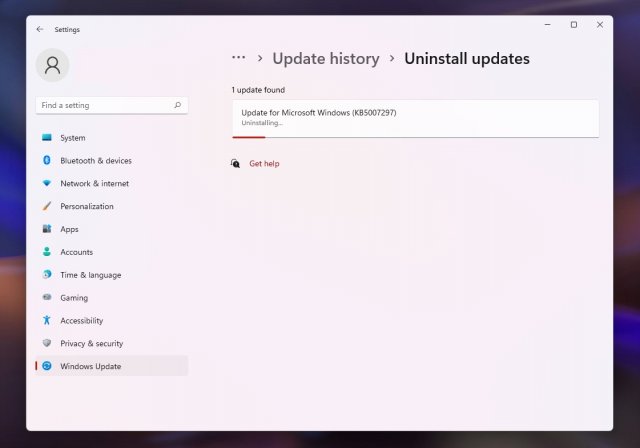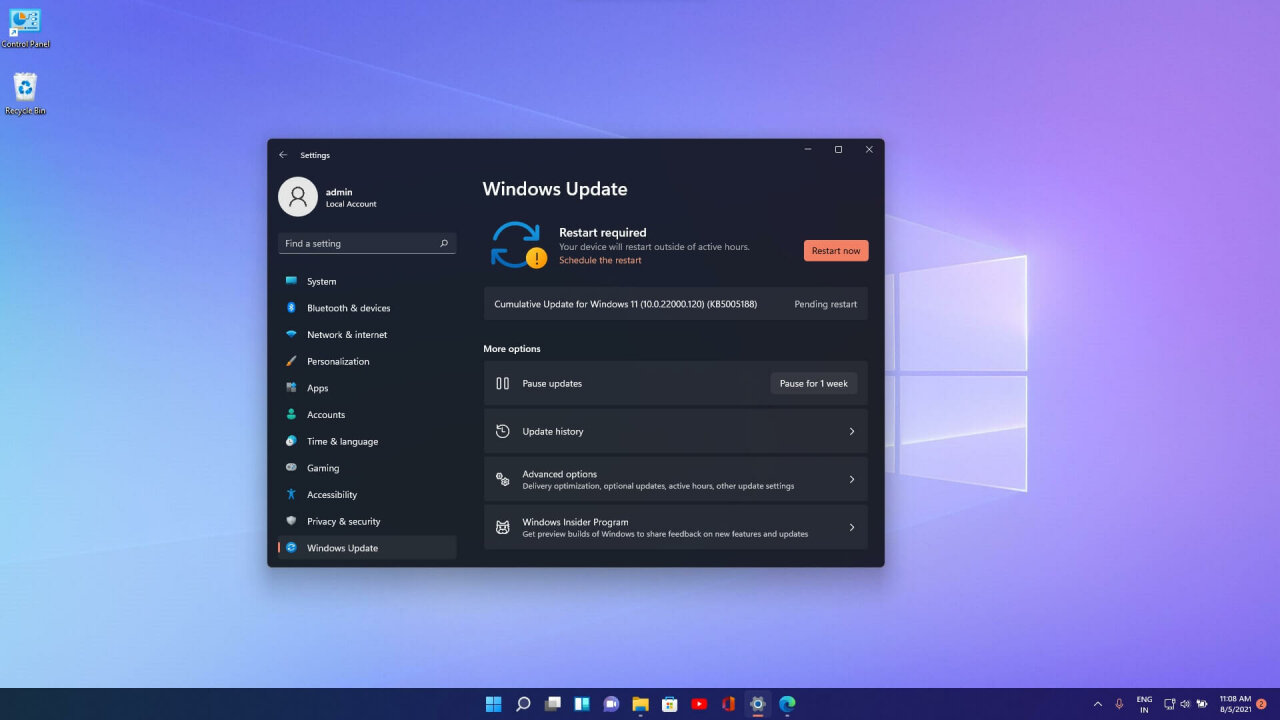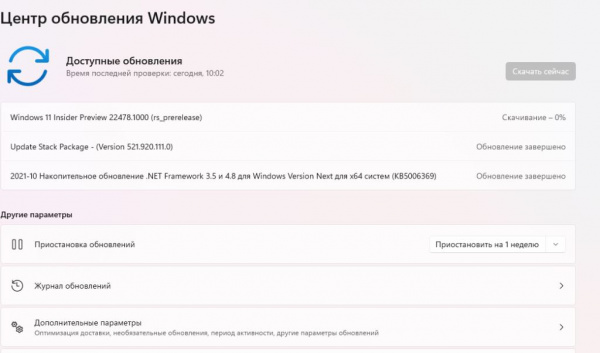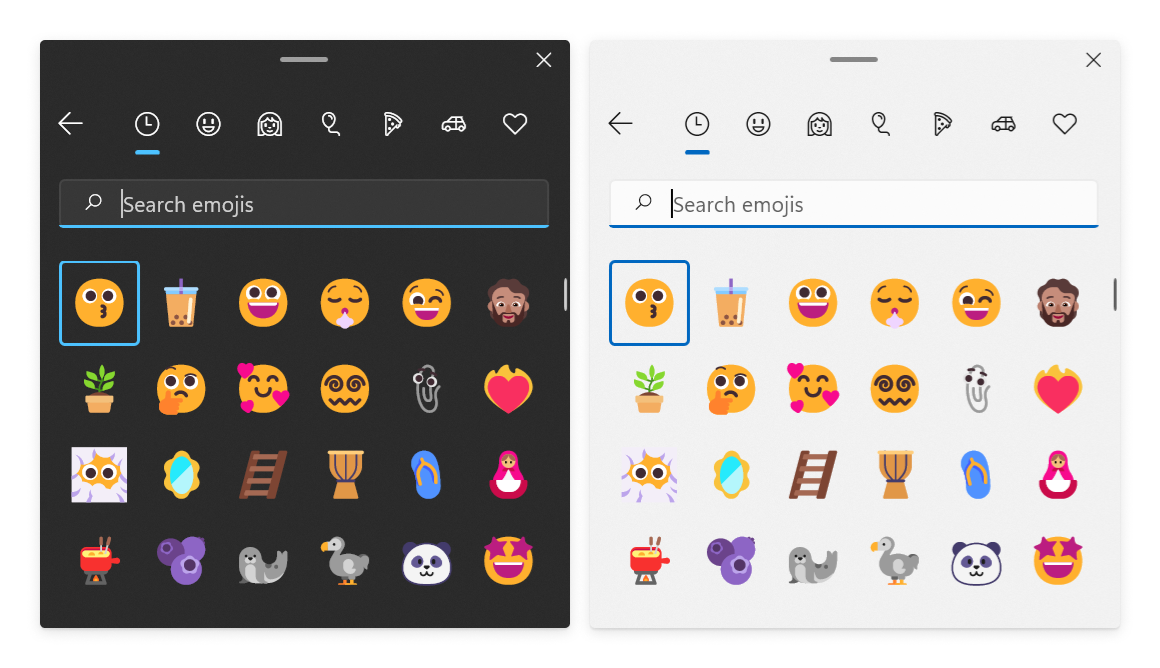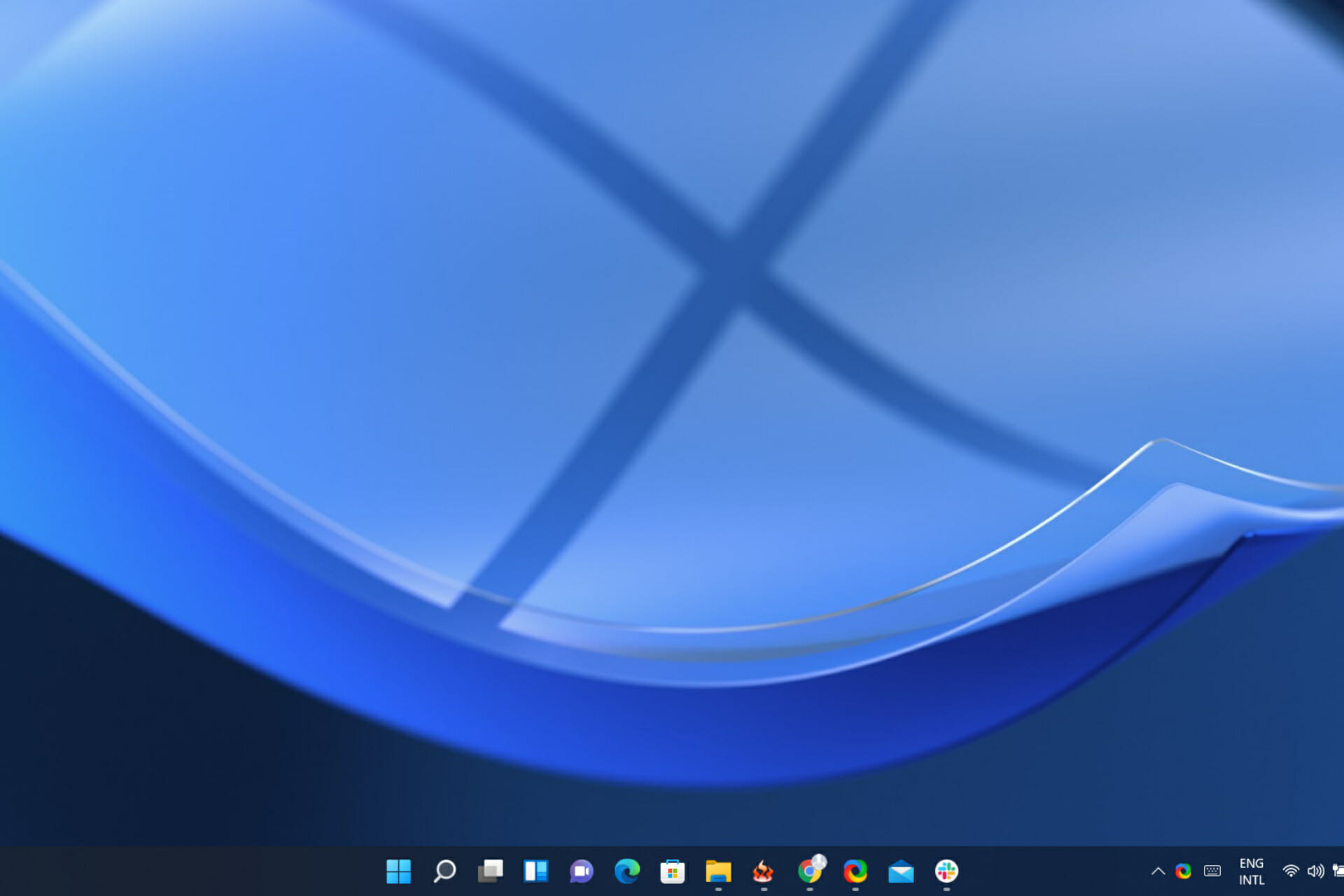В предварительных сборках Microsoft добавила новую функцию Центра обновления Windows под названием «Обновление пакетов стека» в Windows 11. В отличие от пакетов функций или обновлений функций, эти пакеты стека включают набор критических улучшений и компонентов оболочки, которые делают основные выпуски Windows менее проблематичными.
Microsoft не предоставила подробной информации о том, как работают эти пакеты обновления стека, но это может сделать операционную систему более модульной. Используя такие функции, как «Update Stack Packages» и «Experience Packs», Microsoft может продвигать новые функции или улучшения для определенных функций Windows за пределами обычных обновлений ОС.
«Update Stack Packages» будут автоматически устанавливаться помимо обычных предварительных выпусков или выпусков безопасности, и пользователи заметят его присутствие при проверке обновлений. Сегодня Microsoft выпустила новую версию пакета стека с номером 822.124.211.0, в которой нет новых функций.
Цель Windows Stack Packages не совсем ясна, но, по словам Microsoft, ее можно использовать для улучшения процесса обновления.
Эти пакеты будут выпущены перед ежемесячным накопительным обновлением или обновлением функций, и Microsoft ранее заявляла, что эта функция поможет обеспечить стабильность вашего ПК.
На данный момент Update Stack Packages ограничен небольшим набором улучшений, связанных с обновлениями, но вы можете ожидать дополнительных улучшений в будущих выпусках. На данный момент Microsoft хочет протестировать только системные файлы, связанные с незначительными обновлениями, за пределами основных выпусков Windows.
Update Stack Packages доставляются через Центр обновления Windows так же, как и накопительные обновления. Другими словами, вы найдете эти пакеты стека в меню «Параметры» > «Центр обновления Windows».
Помимо пакета стека Центра обновления Windows и нескольких других изменений в Центре обновления Windows, следующее обновление функций для Windows 11 также содержит обычную пачку новых функций и улучшений. Например, приложение «Параметры» было обновлено, чтобы предложить больше возможностей для управления обновлениями Windows, которые вы обычно найдете в Панели управления.
Прямо сейчас, если вы хотите удалить обновления, вам нужно зайти на страницу Центра обновления Windows в Панели управления, которая является частью Windows, начиная с Windows 1.0. В Windows 11 22H2, также известной как Sun Valley 2 , Microsoft наконец-то перенесла функцию по удалению обновлений в приложение «Параметры».
Microsoft начала тестирование нового способа доставки улучшений для Windows 11 отдельно от крупных обновлений ОС. Начиная со сборки 22478 участники программы Windows Insider на канале Dev будут получать пакеты Update Stack Package, которые будут включать в себя улучшения для процесса обновления. Они будут распространяться перед выходом ежемесячного накопительного обновления или крупного функционального обновления. Этот пакет позволит гарантировать, что новые обновления будут успешно устанавливаться на вашем компьютере.
На текущий момент Update Stack Package ограничен весьма небольшим набором системных файлов, связанных с обновлениями, которые разрабатываются отдельно от ОС. После тестирования в программе Windows Insider планируется расширить сферу применения этих обновлений, а также увеличить частоту их выпуска.
Update Stack Package будут доставляться участникам программы Windows Insider через «Центр обновления Windows», то есть так же, как новые сборки и накопительные обновления. Если вы используете сборки с канала Dev, то перейдите в «Параметры» -> «Центр обновления Windows» и нажмите на кнопку «Проверить наличие обновлений», чтобы получить пакет Update Stack Package.
Microsoft выпустила еще один пакет стека обновлений для Windows 11, продолжая тестировать эту новую функцию, чтобы обеспечить улучшение качества за пределами основных обновлений функций Windows. С пакетами стека обновлений Microsoft, также надеется свести к минимуму проблемы с установкой, вызванные определенными обновлениями.

Компания начала тестировать пакет обновления стека со сборки 22478 или новее, и позже в этом году она начнет предлагать эту функцию всем. Microsoft выпустила еще одну версию «Update Stack Package 1022.705.1011.0» с неизвестным количеством исправлений или улучшений, поскольку журнал изменений недоступен.
Пакет стека обновлений поможет гарантировать, что ваш компьютер будет иметь наибольшую вероятность успешной установки новых обновлений с наилучшей и наименее разрушительной работой.
Сегодняшний пакет стека обновлений 1022.705.1011.0, по-видимому, распространяется только на пользователей Dev Channel. Если все пойдет по плану, пакеты стека обновлений появятся в производственном канале после выпуска Windows 11 версии 22H2 (Sun Valley 2) осенью.
Мы не знаем, как именно пакеты стека обновлений улучшат работу Центра обновления Windows, но официальные лица Microsoft ранее объясняли, что пакеты будут развернуты для повышения стабильности, когда ежемесячное обновление или обновление функций не за горами.
Другими словами, пакеты стека обновлений представляют собой небольшие обновления, которые будут доставлены до накопительных обновлений, чтобы уменьшить количество проблем, о которых сообщается после или во время установки обновления. Например, вы можете ожидать меньше ошибок при установке, если установите пакет стека перед основным накопительным обновлением.
На данный момент Microsoft тестирует эту функцию в предварительных сборках и ограничена только Dev Channel только небольшим набором неизвестных улучшений. Вполне вероятно, что это начнется для устройств под управлением Windows 11 версии 21H2, если оно окажется успешным.
Microsoft начала тестирование нового способа доставки улучшений для Windows 11 отдельно от крупных обновлений ОС. Начиная со сборки 22478 участники программы Windows Insider на канале Dev будут получать пакеты Update Stack Package, которые будут включать в себя улучшения для процесса обновления. Они будут распространяться перед выходом ежемесячного накопительного обновления или крупного функционального обновления. Этот пакет позволит гарантировать, что новые обновления будут успешно устанавливаться на вашем компьютере.
На текущий момент Update Stack Package ограничен весьма небольшим набором системных файлов, связанных с обновлениями, которые разрабатываются отдельно от ОС. После тестирования в программе Windows Insider планируется расширить сферу применения этих обновлений, а также увеличить частоту их выпуска.
Update Stack Package будут доставляться участникам программы Windows Insider через «Центр обновления Windows», то есть так же, как новые сборки и накопительные обновления. Если вы используете сборки с канала Dev, то перейдите в «Параметры» -> «Центр обновления Windows» и нажмите на кнопку «Проверить наличие обновлений», чтобы получить пакет Update Stack Package.

В предварительных сборках Microsoft добавила новую функцию Центра обновления Windows под названием «Обновление пакетов стека» в Windows 11. В отличие от пакетов функций или обновлений функций, эти пакеты стека включают набор критических улучшений и компонентов оболочки, которые делают основные выпуски Windows менее проблематичными.
Microsoft не предоставила подробной информации о том, как работают эти пакеты обновления стека, но это может сделать операционную систему более модульной. Используя такие функции, как «Update Stack Packages» и «Experience Packs», Microsoft может продвигать новые функции или улучшения для определенных функций Windows за пределами обычных обновлений ОС.
«Update Stack Packages» будут автоматически устанавливаться помимо обычных предварительных выпусков или выпусков безопасности, и пользователи заметят его присутствие при проверке обновлений. Сегодня Microsoft выпустила новую версию пакета стека с номером 822.124.211.0, в которой нет новых функций.
Цель Windows Stack Packages не совсем ясна, но, по словам Microsoft, ее можно использовать для улучшения процесса обновления.
Эти пакеты будут выпущены перед ежемесячным накопительным обновлением или обновлением функций, и Microsoft ранее заявляла, что эта функция поможет обеспечить стабильность вашего ПК.
На данный момент Update Stack Packages ограничен небольшим набором улучшений, связанных с обновлениями, но вы можете ожидать дополнительных улучшений в будущих выпусках. На данный момент Microsoft хочет протестировать только системные файлы, связанные с незначительными обновлениями, за пределами основных выпусков Windows.
Update Stack Packages доставляются через Центр обновления Windows так же, как и накопительные обновления. Другими словами, вы найдете эти пакеты стека в меню «Параметры» > «Центр обновления Windows».
Помимо пакета стека Центра обновления Windows и нескольких других изменений в Центре обновления Windows, следующее обновление функций для Windows 11 также содержит обычную пачку новых функций и улучшений. Например, приложение «Параметры» было обновлено, чтобы предложить больше возможностей для управления обновлениями Windows, которые вы обычно найдете в Панели управления.
Прямо сейчас, если вы хотите удалить обновления, вам нужно зайти на страницу Центра обновления Windows в Панели управления, которая является частью Windows, начиная с Windows 1.0. В Windows 11 22H2, также известной как Sun Valley 2 , Microsoft наконец-то перенесла функцию по удалению обновлений в приложение «Параметры».
As part of Windows 11 Insider Preview build 22478 in the Dev Channel, Microsoft is starting to test a new way to update the servicing stack in Windows.
What are Update Stack Packages?
Update Stack Packages deliver changes to the Windows 11 update experience before a monthly cumulative update (CU), or yearly feature update, is pushed out to Windows 11 devices. Update Stack Packages shouldn’t be confused with servicing stack updates or feature experience packs.
Microsoft says in a post on the Windows blog announcing the release of Windows 11 Insider Preview build 22478, that “The Update Stack Package will help ensure that your PC has the highest likelihood of successfully installing new updates with the best and least disruptive experience available.”
At this time, the Update Stack Package feature is restricted to updating a small set of update-related system files that Microsoft engineers work on independently from the OS. Microsoft says that by testing this new feature with Windows Insiders first, it hopes to expand the scope and frequency of Update Stack Package releases going forward. Microsoft goes on to detail how Insiders will get Update Stack Packages:
“Update Stack Packages will be delivered to Insiders through Windows Update just like builds and cumulative updates are. Insiders in the Dev Channel today can go to Settings > Windows Update and Check for updates to receive the Update Stack Package.”
Update State Package vs Servicing Stack Update
How Update State Packages differ from servicing stack updates is unclear currently. Microsoft hasn’t revealed much in the way of technical detail in its latest blog post. It could be that Update State Packages are an evolution of servicing stack updates.
Microsoft says that “Servicing stack updates provide fixes to the servicing stack, the component that installs Windows updates. Additionally, it contains the “component-based servicing stack” (CBS), which is a key underlying component for several elements of Windows deployment, such as DISM, SFC, changing Windows features or roles, and repairing components. The CBS is a small component that typically does not have updates released every month.”
Earlier this year, Microsoft started delivering monthly cumulative updates and servicing stack updates together via Windows Server Update Services (WSUS) and the Microsoft Catalog, to provide a single cumulative update payload. Prior to February 2021, servicing updates were supposed to be installed separately before subsequent cumulative or feature updates could be applied.
Windows Feature Experience Packs
Another type of update that Microsoft has been testing with Insiders, and which I expect Microsoft to use more in Windows 11, is the feature experience pack. These packs are designed to add features to Windows independently of a feature update.
Because Windows 11 has shipped with quite a few Windows 10 power user features missing, Microsoft could opt to use feature experience packs to deliver those features in Windows 11. That would mean users don’t need to wait a year for the first Windows 11 feature update. But it remains to be seen whether features like Jump Lists, and the ability to group apps on the Start menu, will be added to Windows 11.
Written By
published
October 14, 2021
UPDATE 10/15: We are starting to roll out Cumulative Update Build 22478.1012 (KB5007328). This update does not include anything new and is designed to test our servicing pipeline for builds in the Dev Channel.
—————————————————————————
Hello Windows Insiders, today we are releasing Windows 11 Insider Preview Build 22478 to the Dev Channel.
TL;DR
- To celebrate the 7-year anniversary of the Windows Insider Program, we’re releasing special desktop backgrounds designed by the Microsoft Design Team.
- The much-anticipated new Fluent emoji are now included in this build!
- We have begun testing Update Stack Packages that deliver update improvements outside of major OS updates such as new builds.
- Build Expiration Reminder: We have updated the build expiration for Dev Channel builds to be 9/15/2022. Previous Dev Channel builds from the RS_PRERELEASE branch will expire on 10/31/2021. To avoid hitting this expiration, please be sure to update to the latest Dev Channel build today.
7 years of the Windows Insider Program
October has been a big month for us. Not only did we launch Windows 11 to the world with the help of you, our Windows Insiders, we’re also celebrating our 7 year anniversary. To celebrate our anniversary this year, we are releasing special desktop backgrounds designed by the Microsoft Design Team to show off being Microsoft and Windows 11 fans! Download the special background here for dark theme and here for light theme.
😍 Excited to celebrate the 7th Anniversary of the #WindowsInsider program & the AMAZING community of Insiders that have made this year so memorable!🎉
As is our tradition, we’ve designed a set of wallpapers just for Insiders now available at https://t.co/bAN970Rag7 – Go get ’em! pic.twitter.com/KFY2FbMveR— Amanda Langowski (@amanda_lango) October 14, 2021
What’s new in Build 22478
New Fluent Emoji
Back in July, the Microsoft Design Team announced refreshed and new Fluent-designed emoji that would roll out across all of Microsoft 365 – including Windows. We are excited to be giving Windows Insiders a “first look” at how our new emoji design will look in Windows 11 starting with today’s Dev Channel build.
Emoji have become part of the way we communicate. Extending our expression by providing humor, feelings, and fun. You will notice we have redesigned all the emoji and introduced some nostalgia for our fans by making the standard paperclip emoji our beloved Clippy! As part of this rollout, we’re adding support for Unicode emoji up to Emoji 13.1 which includes new emoji such as face in the clouds, heart on fire, space with spiral eyes plus many more!
To check out the new emoji, just open up the emoji panel (WIN + . )!
After previewing these with Windows Insiders, we plan to bring these new emoji to everyone on Windows 11 via a future servicing update.
Changes and Improvements
- The updated version of the Korean IME, which began rolling out with Build 22454, is now available to everyone in the Dev Channel.
- When your laptop is closed, it’s now possible to login to your PC using Facial Recognition (Windows Hello) on a connected external monitor if it has a camera attached that supports it.
- We’ve made a change to the underlying indexer platform to help improve overall reliability and database size, which should help reduce disk space usage on the system – particularly in cases where users had very large Outlook mailboxes.
- Scrolling your mouse wheel on the volume icon in the Taskbar will now change the current volume level.
- Made some small adjustments to the dialog when adding a new language in Settings to make it look a little more modern, including rounding the corners.
Fixes
[Start]
- Keyboard focus will no longer get lost if you press ESC after opening the user profile flyout in Start.
- Updated the prompt text when pinning something from a UWP app to Start, so it now says simply “Do you want to pin this to Start?”.
[Taskbar]
- Addressed an issue that was causing Notification Center to get stuck in a state in recent builds where it would stop launching.
- The plus icon for adding a new Desktop will now display properly when hovering over the Task View icon in the Taskbar when using Arabic and Hebrew languages.
- After bringing up an app’s jump list from the Taskbar, right clicking on the app name should now show the correct icon for Pin to Start (a pin icon).
- Left and right clicking Taskbar at the same time should no longer crash explorer.exe.
[File Explorer]
- Fixed an issue where the command bar was doing unnecessary calculations when navigating to folders, causing an unexpected decrease in performance. This is also believed to be the root cause of performance issues when using drag to select files, as well as using the arrow keys to navigate in certain folders.
- The “Show hidden items” option should no longer get out of sync when multiple File Explorer windows are open.
[Widgets]
The following two issues have been addressed with Microsoft Edge version 95, currently live for Microsoft Edge Insiders, and as such we’re removing them from the known issues list:
- The widgets board may appear empty.
- Widgets may be displayed in the wrong size on external monitors.
[Search]
- The recent searches flyout when hovering over the search icon in the Taskbar should no longer immediately dismiss on invocation if an admin window is in focus.
[Input]
- Setting focus to the search box in File Explorer shouldn’t make the touch keyboard invoke and immediately dismiss now when using a tablet with the Taskbar set to auto-hide.
- Fixed an issue causing the handwriting panel to not insert text when using it to write Chinese.
- Mitigated a memory leak that could occur in ctfmon, causing unexpected resource usage over time.
- Addressed an issue for a small number of users that was causing TextInputHost.exe crashes when setting focus on any text field.
[Settings]
- Fixed an issue that was causing Settings to crash when radio buttons were updated, for example if you connected an additional audio endpoint while the Sound page in Settings was open.
- Improved performance of loading the themes displayed in Personalization Settings.
- If a non-admin user changes their display language in Language Settings, we’ll no longer show the clickable sign-out button there as it was popping a UAC dialog and causing confusion.
- The Windows Update entry at the top of the System page in Settings should no longer be misaligned with the other options (when shown) in languages like German.
- The Braille options in Settings for Narrator users should now be in sync with the actual state of the Braille input/output mode.
- Made a change to help address an issue where “Media streaming options” in the Network and Sharing Center would unexpectedly revert to default settings after an upgrade.
- Improved Quick Settings launch reliability. This change should also help address the issue causing the window to not fully render (just a thin rectangle).
- Addressed an issue where if you clicked on the media controls area in Quick Settings, it wasn’t bringing the app displayed to the foreground in certain cases.
- Fixed an issue where the colors for items in Quick Settings could get stuck and not reflect the proper color for that state, particularly when using a contrast theme.
- Updated the Quick Settings page for managing audio endpoints from “Volume” to “Sound output”.
- Opening the page for managing audio endpoints in Quick Settings should no longer cause a brief cut in audio playback when multiple devices are listed.
[Windowing]
- Mitigated an issue related to using ALT + Tab very quickly that could make explorer.exe crash.
- Holding down ALT and pressing F4 after pressing ALT + Tab will no longer crash explorer.exe.
- When using the Arabic or Hebrew display languages, dragging an app window to a different Desktop should show the thumbnail moving in the correct direction now.
[Other]
- Fixed a casing issue that was causing LP.cab files to be unexpectedly removed in certain cases, which could lead you your display language changing until you added the desired display language back in Settings.
- Addressed an issue that was causing some users to see a bugcheck with error “KERNEL_SECURITY_CHECK_ERROR”.
- Mitigated an issue that was causing the SysMain service to use an unexpected amount of power in recent builds.
- If the display order is missing in BCD settings that should no longer cause an upgrade failure.
- Fixed an issue that was causing captions to draw at the wrong offset in certain apps.
- Mitigated an issue that was causing crashes related to audiosrv.dll.
- If going through OOBE with an Arabic or Hebrew display language, the volume and accessibility buttons should display on the correct side of the screen now.
NOTE: Some fixes noted here in Insider Preview builds from the active development branch may make their way into the servicing updates for the released version of Windows 11 that became generally available on October 5th.
Known issues
[General]
- Users updating from Builds 22000.xxx, or earlier, to newer Dev Channel builds using the latest Dev Channel ISO, may receive the following warning message: The build you are trying to install is Flight Signed. To continue installing, enable flight signing. If you receive this message, press the Enable button, reboot the PC, and retry the update.
- Some users may experience their screen and sleep timeouts being reduced. We’re investigating the potential impact that shorter screen and sleep timeouts could have on energy consumption.
[Start]
- In some cases, you might be unable to enter text when using Search from Start or the Taskbar. If you experience the issue, press WIN + R on the keyboard to launch the Run dialog box, then close it.
[Taskbar]
- The Taskbar will sometimes flicker when switching input methods.
- We’re working on the fix for an issue causing tooltips to appear in an unexpected location after hovering over the Taskbar corner.
[Search]
- After clicking the Search icon on the Taskbar, the Search panel may not open. If this occurs, restart the “Windows Explorer” process, and open the search panel again.
- Search panel might appear as black and not display any content below the search box.
[Quick Settings]
- We’re investigating reports from Insiders that the volume and brightness sliders aren’t displaying properly in Quick Settings.
Introducing Update Stack Packages
We are beginning to test a new process for delivering new update improvements to our customers outside of major OS updates with Windows Insiders in the Dev Channel starting with Build 22478. Through the Update Stack Package, we can deliver improvements to the update experience prior to the PC taking a monthly or Feature Update. The Update Stack Package will help ensure that your PC has the highest likelihood of successfully installing new updates with the best and least disruptive experience available.
Currently, the Update Stack Package is limited to a very small set of update-related system files that are developed independently of the OS. By testing this process first with Windows Insiders, we hope to expand the scope and the frequency of releases in the future.
Update Stack Packages will be delivered to Insiders through Windows Update just like builds and cumulative updates are. Insiders in the Dev Channel today can go to Settings > Windows Update and check for updates to receive the Update Stack Package.
About the Dev Channel
We have moved the Dev Channel back to receiving builds from our active development branch (RS_PRERELEASE). These builds are from the earliest stage in a new development cycle with the latest work-in-progress code from our engineers. These aren’t always stable builds, and sometimes you will see issues that block key activities or require workarounds while flighting in the Dev Channel. It is important to make sure you read the known issues listed in our blog posts as we document many of these issues with each flight.
These builds are also not matched to a specific release. New features and OS improvements from these builds could show up in future Windows releases when they’re ready, and we may deliver them as full OS updates or servicing releases.
Build numbers are higher in the Dev Channel than the Windows 11 preview builds in the Beta and Release Preview Channels. You will not be able to switch from the Dev Channel to the Beta or Release Preview Channels without doing a clean install back to the released version of Windows 11 currently.
Are you not seeing any of the features listed for this build? Check your Windows Insider Settings to make sure you’re in the Dev Channel. Submit feedback here to let us know if things weren’t working the way you expected.
The desktop watermark you see at the lower right corner of your desktop is normal for these pre-release builds.
Important Insider Links
- Want to learn how we made Windows 11? Check out our Inside Windows 11 website to hear and meet our makers from Engineering, Design and Research to share their insights and unique perspectives throughout this journey.
- You cancheck out our Windows Insider Program documentation here, including a list of all the new features and updates released in builds so far.
- Check out Flight Hub for a complete look at what build is in which Insider channel.
Thanks,
Amanda & Brandon
by Alexandru Poloboc
With an overpowering desire to always get to the bottom of things and uncover the truth, Alex spent most of his time working as a news reporter, anchor,… read more
Published on October 15, 2021
- We know that Windows 11 has officially been released, but there are still Insider builds.
- The Dev Channel just received one of them, with some interesting new features to look at.
- With Preview Build 22478, Insiders get the new fluent emojis and a lot of changes and fixes.
- Also in its testing phase is the Update Stack Packages feature, which will be more than useful.
Did you know that a new Windows 11 build is now available for Insiders in the Dev Channel? Not only that, but it also finally adds a few post-RTM additions to the new system.
October really has been a busy month for Microsoft, not only for releasing Windows 11 to the world, but the company is also celebrating the Insider program’s 7 year anniversary.
To help commemorate this anniversary, Microsoft is releasing special desktop backgrounds for you to show off being a major Windows 11 fan!
You can download the special background here for the dark theme and here for the light theme.
What’s new in build 22478?
Well, let’s start with the redesigned emoji pack since this is the hot topic of the day. Back in July, the Microsoft Design Team announced refreshed and new Fluent-designed emoji that would roll out across all of Microsoft 365 – including Windows.
Insiders are now getting a first look at how the new emojis will look in Windows 11 starting with this latest Dev Channel build.
And since we’re talking about this, you might also want to know that we could only see these new and cool emojis on certain apps, not across the whole operating system, as we initially thought.
Some of the other changes, as well as improvements that have been made to this version of the OS, include:
- The updated version of the Korean IME, which began rolling out with Build 22454, is now available to everyone in the Dev Channel.
- When your laptop is closed, it’s now possible to login to your PC using Facial Recognition (Windows Hello) on a connected external monitor if it has a camera attached that supports it.
- Changes were made to the underlying indexer platform to help improve overall reliability and database size, which should help reduce disk space usage on the system – particularly in cases where users had very large Outlook mailboxes.
- Scrolling your mouse wheel on the volume icon in the Taskbar will now change the current volume level.
- Some small adjustments were made to the dialog when adding a new language in Settings to make it look a little more modern, including rounding the corners.
Microsoft is introducig Update Stack Packages
Besides other projects that they are currently working on, Microsoft decided to test a process for delivering new update improvements to users outside of major OS updates with Windows Insiders in the Dev Channel starting with Build 22478.
Through the Update Stack Package, developers can deliver improvements to the update experience prior to the PC taking a monthly or Feature Update.
This will help ensure that your PC has the highest likelihood of successfully installing new updates with the best and least disruptive experience available.
For the time being, the Update Stack Package is limited to a very small set of update-related system files that are developed independently of the OS.
By testing this process first with Windows Insiders, the company aims to expand the scope and the frequency of releases in the future.
Update Stack Packages will be delivered to Insiders through Windows Update just like builds and cumulative updates are.
What about fixes?
It’s time to look at some fixes and figure out what the tech giant has actually fixed through this software release.
Some PC issues are hard to tackle, especially when it comes to corrupted repositories or missing Windows files. If you are having troubles fixing an error, your system may be partially broken.
We recommend installing Restoro, a tool that will scan your machine and identify what the fault is.
Click here to download and start repairing.
[Start]
- Keyboard focus will no longer get lost if you press ESC after opening the user profile flyout in Start.
- Updated the prompt text when pinning something from a UWP app to Start, so it now says simply “Do you want to pin this to Start?”.
[Taskbar]
- Addressed an issue that was causing Notification Center to get stuck in a state in recent builds where it would stop launching.
- The plus icon for adding a new Desktop will now display properly when hovering over the Task View icon in the Taskbar when using Arabic and Hebrew languages.
- After bringing up an app’s jump list from the Taskbar, right clicking on the app name should now show the correct icon for Pin to Start (a pin icon).
- Left and right clicking Taskbar at the same time should no longer crash explorer.exe.
[File Explorer]
- Fixed an issue where the command bar was doing unnecessary calculations when navigating to folders, causing an unexpected decrease in performance. This is also believed to be the root cause of performance issues when using drag to select files, as well as using the arrow keys to navigate in certain folders.
- The Show hidden items option should no longer get out of sync when multiple File Explorer windows are open.
[Widgets]
The following two issues have been addressed with Microsoft Edge version 95, currently live for Microsoft Edge Insiders, and as such we’re removing them from the known issues list:
- The widgets board may appear empty.
- Widgets may be displayed in the wrong size on external monitors.
[Search]
- The recent searches flyout when hovering over the search icon in the Taskbar should no longer immediately dismiss on invocation if an admin window is in focus.
[Input]
- Setting focus to the search box in File Explorer shouldn’t make the touch keyboard invoke and immediately dismiss now when using a tablet with the Taskbar set to auto-hide.
- Fixed an issue causing the handwriting panel to not insert text when using it to write Chinese.
- Mitigated a memory leak that could occur in ctfmon, causing unexpected resource usage over time.
- Addressed an issue for a small number of users that was causing TextInputHost.exe crashes when setting focus on any text field.
[Settings]
- Fixed an issue that was causing Settings to crash when radio buttons were updated, for example if you connected an additional audio endpoint while the Sound page in Settings was open.
- Improved performance of loading the themes displayed in Personalization Settings.
- If a non-admin user changes their display language in Language Settings, we’ll no longer show the clickable sign-out button there as it was popping a UAC dialog and causing confusion.
- The Windows Update entry at the top of the System page in Settings should no longer be misaligned with the other options (when shown) in languages like German.
- The Braille options in Settings for Narrator users should now be in sync with the actual state of the Braille input/output mode.
- Made a change to help address an issue where “Media streaming options” in the Network and Sharing Center would unexpectedly revert to default settings after an upgrade.
- Improved Quick Settings launch reliability. This change should also help address the issue causing the window to not fully render (just a thin rectangle).
- Addressed an issue where if you clicked on the media controls area in Quick Settings, it wasn’t bringing the app displayed to the foreground in certain cases.
- Fixed an issue where the colors for items in Quick Settings could get stuck and not reflect the proper color for that state, particularly when using a contrast theme.
- Updated the Quick Settings page for managing audio endpoints from “Volume” to “Sound output”.
- Opening the page for managing audio endpoints in Quick Settings should no longer cause a brief cut in audio playback when multiple devices are listed.
[Windowing]
- Mitigated an issue related to using ALT + Tab very quickly that could make explorer.exe crash.
- Holding down ALT and pressing F4 after pressing ALT + Tab will no longer crash explorer.exe.
- When using the Arabic or Hebrew display languages, dragging an app window to a different Desktop should show the thumbnail moving in the correct direction now.
[Other]
- Fixed a casing issue that was causing LP.cab files to be unexpectedly removed in certain cases, which could lead you your display language changing until you added the desired display language back in Settings.
- Addressed an issue that was causing some users to see a bugcheck with error “KERNEL_SECURITY_CHECK_ERROR”.
- Mitigated an issue that was causing the SysMain service to use an unexpected amount of power in recent builds.
- If the display order is missing in BCD settings that should no longer cause an upgrade failure.
- Fixed an issue that was causing captions to draw at the wrong offset in certain apps.
- Mitigated an issue that was causing crashes related to audiosrv.dll.
- If going through OOBE with an Arabic or Hebrew display language, the volume and accessibility buttons should display on the correct side of the screen now.
NOTE
Some fixes from the active development branch may make their way into the servicing updates for the released version of Windows 11 that became generally available on October 5th.
Any known issues with the new build?
[General]
- Users updating from Builds 22000.xxx, or earlier, to newer Dev Channel builds using the latest Dev Channel ISO, may receive the following warning message: The build you are trying to install is Flight Signed. To continue installing, enable flight signing. If you receive this message, press the Enable button, reboot the PC, and retry the update.
- Some users may experience their screen and sleep timeouts being reduced. We’re investigating the potential impact that shorter screen and sleep timeouts could have on energy consumption.
[Start]
- In some cases, you might be unable to enter text when using Search from Start or the Taskbar. If you experience the issue, press WIN + R on the keyboard to launch the Run dialog box, then close it.
[Taskbar]
- The Taskbar will sometimes flicker when switching input methods.
- Working on the fix for an issue causing tooltips to appear in an unexpected location after hovering over the Taskbar corner.
[Search]
- After clicking the Search icon on the Taskbar, the Search panel may not open. If this occurs, restart the “Windows Explorer” process, and open the search panel again.
- Search panel might appear as black and not display any content below the search box.
[Quick Settings]
- Microsoft is investigating reports from Insiders that the volume and brightness sliders aren’t displaying properly in Quick Settings.
Are you a Dev Channel Insider? Share your new experience with us in the comments section below.
Still having issues? Fix them with this tool:
SPONSORED
If the advices above haven’t solved your issue, your PC may experience deeper Windows problems. We recommend downloading this PC Repair tool (rated Great on TrustPilot.com) to easily address them. After installation, simply click the Start Scan button and then press on Repair All.

